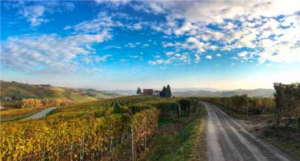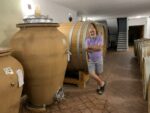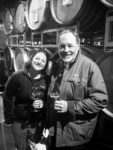Fratelli Borgogno is a small family estate of just 3ha, situated in the heart of the famous cru of Barolo – Cannubi. Today, the fifth generation of the family manages the estate with the same passion and enthusiasm as their ancestors. They always respect the traditions of the wine region, the biodiversity of their vineyards and the expression of the terroir, adapting the work in the vineyard and in the cellar for each vine, each barrel and each vintage.
 VertdeVin: You are located in the heart of Cannubi. What are the peculiarities of the terroir of this part of Barolo?
VertdeVin: You are located in the heart of Cannubi. What are the peculiarities of the terroir of this part of Barolo?
Emanuela Bolla: The peculiarities of Cannubi are certainly to be found in the formation of the soil and its strategic and central position, peculiarities that can give the wine longevity, finesse and elegance.
Cannubi is located right in the centre of the Barolo production area, and specifically our three owned vineyards are in the very heart of Cannubi, on its summit, and extend for a total of about 2.70 ha to which our cellar is attached.
The formation of the soils has very ancient origins that can be traced back to the gradual withdrawal of the Po Sea (Mare Padano) and subsequent seismic and climatic events. Cannubi is often referred to as the union, the union of the two main slopes of the Barolo area, which can be traced back to the formation of the Helvetian and Tortonian periods. The composition of the soil determines complex and surprising peculiarities. The slopes and areas with a higher silty content allow for a greater retention of rainwater and retain moisture in the soil for longer, compared to the sandier areas that tend to disperse rainwater more quickly. Such water storage proves essential during the hottest summer phases. In any case, the prevalence of 46-60%
loamy substance compared to sandy and clayey ones ranging from 15%-25% explains the strong resistance, so far, even during very hot years.
To conclude, Cannubi possesses unique peculiarities to be found in its soil conformation, its position, and its different slopes. The end result is an extremely elegant wine, with more delicate aromas in more traditional vintages and more intense perfumes in warmer vintages. The elegance from the wine’s youthful ageing gives way at the same time to great structure, with pleasantly austere tannins, a symptom of a long-lived wine.
What is the philosophy behind your winery?
E.B.: Our philosophy is based on simple fundamentals, i.e. on acquired traditions, which we like to define as our roots, and on the awareness of a continuous evolution of thought and work that must be able to adapt each activity to the climatic course of the year as far as work in the vineyard is concerned, and consequently to the individual characteristics of each wine and vintage, as far as work in the cellar is concerned.
It is necessary to know where we come from, our history, that of our terroir and our soil, in order to be able to do our best, to achieve our annual goal: to produce genuine wines that can best represent the vintage and the vineyard from which they come.
You are one of the few who work with Nascetta. Tell us what kind of variety it is and how you see its potential.
E.B.: To be fair, I would like to point out that before us, several far-sighted producers, particularly from the Novello area but not only there, have brought this incredible historical variety back to light, preventing it from disappearing. All our admiration
goes to them.
We are certainly one of the few wineries in Barolo to produce Langhe Nascetta, perhaps, but our wish is that more producers will become passionate about this very special variety. Nascetta grape is perhaps one of the few white varieties, which is harvested halfway through the harvest of red grapes. It is normally harvested between Dolcetto (early-ripening) and Nebbiolo/
Barbera (late-ripening) grape harvests.
Its aptitude for ageing and its extremely intense and at the same time elegant organoleptic characteristics are equally astonishing.
Both on the nose and on the palate it develops hints of acacia honey, notes of exotic fruit and citrus fruits, all rounded off by an austere structure and a minerality accentuated according to the vintage that confer extreme longevity.
How is the style of Barolo changing today, in an era of changing climate and consumer tastes?
E.B.: I am extremely curious to read this answer in a decade or more, to evaluate it with a broader historical memory. There is definitely a climate change underway that is affecting and will inevitably affect our vineyards and consequently our grapes and wine. We would like that our consumers continue enjoying our wines.
In spite of the climate change, the vintages currently on the market have given wines with extreme pleasantness in terms of extension of aroma, fullness, velvet, crunchy fruit, enveloping and full structure. To achieve this, it was necessary to adapt to the changes, to work with different expedients than in the past. To avoid over-ripening of the grapes, we have adjusted our harvest dates and vinification work in the cellar.
As far as the general perception of the consumer is concerned, I think we need to wait a few more years. In any case, more and more consumers are paying attention to the sustainability of the authenticity and genuineness of wine. If this is the case, this large group of consumers is learning that wine is a reflection of the vintage and the vineyard from which it comes. For these reasons, wine is inevitably free to have infinite nuances not to be standardised. The beauty of wine is also this.
Thanks to Emanuela Bolla for her welcome
Valéria Tenison
Azienda Agricola Borgogno Serio
Loc. Cannubi, Via Crosia 12
12060 Barolo (Cuneo), Italy
borgognoseriobattista.it





